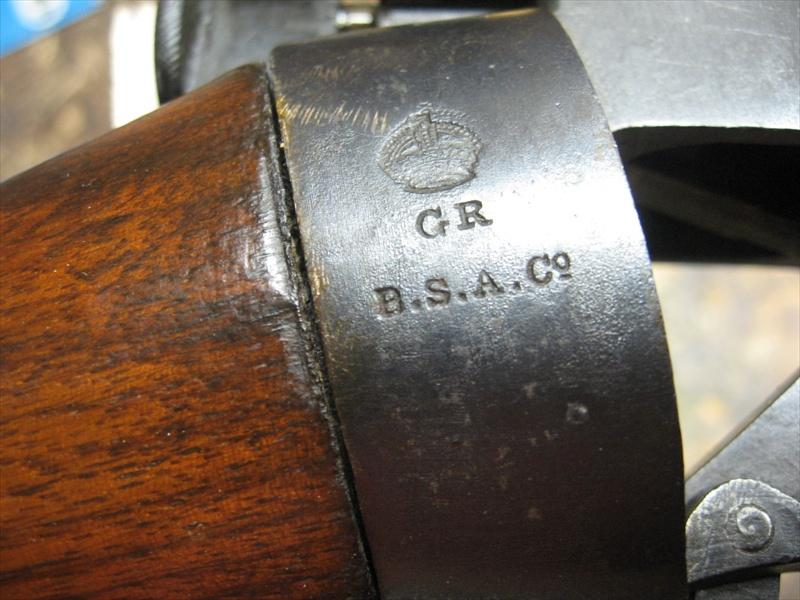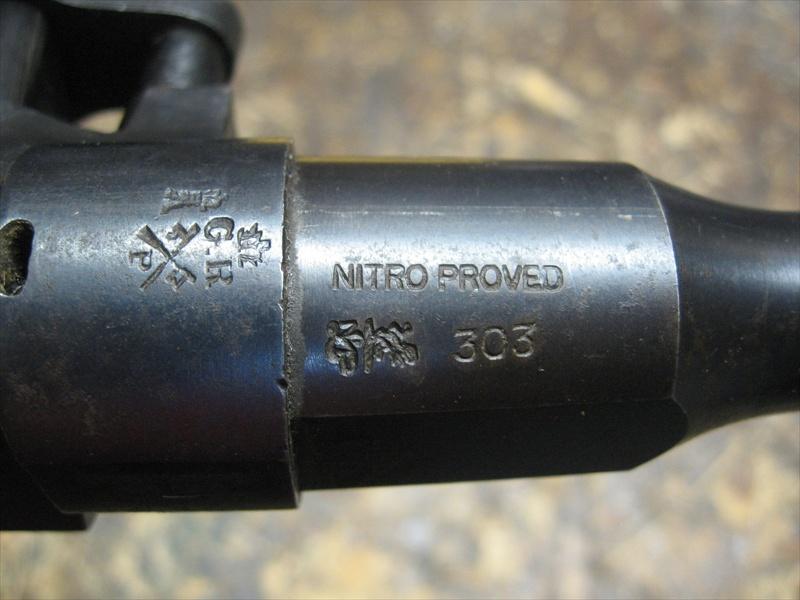-
Deceased January 15th, 2016


Originally Posted by
Cdn303

that restoring it without the volley sights would save me some money. (the rear volley sight has to be removed for the target sight anyhow).
Going by the between the wars London "Military" Proof mark, it is unlikely that it ever had a volley sight.
-
04-05-2012 03:39 AM
# ADS
Friends and Sponsors

-

Originally Posted by
Beerhunter

Going by the between the wars London "Military" Proof mark, it is unlikely that it ever had a volley sight.
Beerhunter,
What London proof mark are you referring to?
The photos are too blurry for me to recognize any of the marks with certainty, but your eyes might be better than mine. Can the owner try to post a few pics using the macro feature on the camera?
The only evidence I can see that this might be a commercial/trade rifle is the lack of a date and model model number on the butt socket. Directly contradicting that identification are all the government marks, including the royal cipher. We shouldn't take the barrel as evidence, because it could have been fitted later (by AG Parker).
Close-up, in-focus pics of the RHS butt socket and LHS of action that show the stamps might settle this mystery.
Cheers
.
.
Researching Lee Speeds and all commercial Lee Enfields. If you have data to share or questions, please send me a PM.
-
-
-
FREE MEMBER
NO Posting or PM's Allowed

I have some more pictures on my photobucket account. Basket Case pictures by Cdn303 - Photobucket I can't take anymore right now b/c the batteries in my camera are dead and the stores will be closed till Saturday, being Easter and all. The RH butt socket only has the crown over GR and B.S.A. CO. Please note that the pictures are all pre-cleaning.
-
Deceased January 15th, 2016

Beerhunter,
What London proof mark are you referring to?
"NITRO PROOVED" over
A Lion Rampant reversed over NLP intertwined next to "303"
-
FREE MEMBER
NO Posting or PM's Allowed

Because you still have the magazine cut off fitted. Try and put it back to WW1 specification. Volly sights were often broken or removed. I have a D/A 1918 SSA SMLE MK1* fitted with a BSA breech. Look under the bolt and you may find some more stampings. Get the long woodwork refitted to make the old girl look good again.
-
Deceased January 15th, 2016


Originally Posted by
LesterH

Because you still have the magazine cut off fitted. Try and put it back to WW1 specification. Volly sights were often broken or removed.
The magazine cut-off and volley sights do not necessarily go together. The former were reinstituted after the Great War but the latter were not. And so adding volley sights, has the danger of turning the rifle into something that it never was.
-
FREE MEMBER
NO Posting or PM's Allowed

As promised, here are some better pictures of the RH wrist and LH knox form


(I forgot to run the q-tip throught the vent hole)
-
Advisory Panel


The remains of a nice commercial No.1 target rifle. Would that be a Central sight base it had with those screws? Looks like it to me.
“There are invisible rulers who control the destinies of millions. It is not generally realized to what extent the words and actions of our most influential public men are dictated by shrewd persons operating behind the scenes.”
Edward Bernays, 1928
Much changes, much remains the same. 
-
-
Advisory Panel


I'm with Beerhunter on this one. It's interesting because it doesn't sport the usual BSA military markings but looks like a "commercial" that was inducted for military service during production. I had 20 of the Bahrain purchase rifles and they are marked as "BSA Co." commercials sans the Royal Cipher. I've been in the repair shop this weekend cleaning up the last four of them so I can post them on the website, (which is way overdue). These inter-war rifles were what I refer to as intermediate Mk.III with the cut offs present but no provision for the volley fire sights. It's hard to tell when they were manufactured because they aren't dated.
-
-
FREE MEMBER
NO Posting or PM's Allowed

Nice project, good find. I've got an AGP Parker Hale almost like this, in full wood. The right wrist markings are only BSA Co, there's no cipher. Its estimated to be early 1920's. It has the cut off, and no volley sights. It has the PH5a sight, which I think is more correct than the plus 5. The 5a's seem to be the commercial choice after the 1920's, and in my opinion others like the Plus 5 would have been an individual owners choice after buying the rifle. The Plus 5 was a design that was superceded with something better, so its reign for serious shooters was not too long.
The screw head reminds me of a Central with its squarish look but the diameter looks smaller, more like the PH5a one I have on the rifle here, narrower screw heads that are a bit taller in the head are what I find on earlier sights like the plus 5..
There are more shooters here with these kind of rifles, not many but some, they're an appreciating collectible and I'm very happy to have found mine. If you continue your restoration I'll post pics for you and I'd bet others will too.
FYI the parker hale forend set up on these rifles is not very modified, and look like stock bedding, which I would bet is very carefully set up. You can see these sometimes at JoeSalter.com, an always interesting website and shop.
A couple of useful website sites are Enfield Resource.com, a links site to the (whole) world of Enfield, and there's links there to my other site, enfield accurizing at youtube.
Dating these rifles has not been straightforward for anyone asking the question, its too bad.
cheers Roger.
Last edited by RJW NZ; 04-30-2012 at 03:54 AM.















 Register To Reply
Register To Reply














